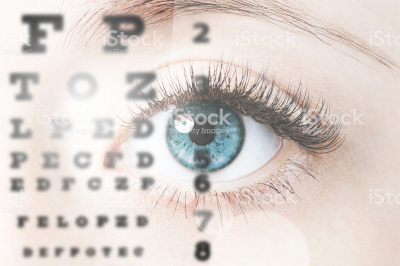
A comprehensive eye exam allows the doctor to evaluate your visual system as well as the overall health of your eye internally and externally. This exam will allow the doctor to determine your ocular health status, prescription, and address any visual concerns you may have. We recommend our patients to have their eyes checked annually for preventative measures.
The eye exam is a multi-step process that may include the following tests:
Visual Acuity – measures the sharpness of your vision
Color Vision Testing – to rule out color blindness
Ocular Motility – how well your eyes follow a moving target
Stereopsis – depth perception test
Refraction – measuring the prescription that you need for your new glasses or contact lenses
Slit Lamp – using a microscope to examine the structures of your eyes in detail
Tonometry – Measuring the pressure inside your eyes to check for glaucoma. We use the iCare tonometer and the Goldmann Tonometer for this testing. We no longer use the “air puff” (i.e. NCT) testing method.
Dilation – Drops enlarge the pupil to allow the doctor to view the internal structures of the eyes; this allows to check for retinal pathology
Why is Dilation Necessary?
Getting your eyes dilated isn’t a pleasant experience, but it is often a necessary part of a comprehensive eye exam.
During your exam, your eye doctor will use eye drops that cause your pupils to dilate, allowing more light into your eyes. The wider your pupils are, the better your doctor can see the back portion of your eye, including the retina and optic nerve. A dilated eye enables your eye doctor to check for signs of damage or disease.
- Eye tumors
- Diabetic retinopathy
- Macular degeneration
- Glaucoma
- Retinal detachment
Eye dilation can even help diagnose underlying health problems that could affect your vision, such as diabetes, high blood pressure, vasculitis and infectious diseases.
Side Effects of Dilation
If you have ever had your eyes dilated, you know how it is difficult to focus on objects close up for a few hours after your exam. Eye dilation also makes your eyes more sensitive to bright light. If you know you will have your eyes dilated, you may want to make arrangements to have a friend or family member drive you home, and you may even need to take the rest of the day off work.
There are some alternatives to eye dilation, but none are as effective. A dilated eye exam is often the only way to detect eye diseases in early stages, which could help save your vision from permanent damage.
Though it can be inconvenient, dilated eye exams are necessary, depending on your eye health and the condition of your eyes. If you have never had your eyes dilated, talk to your eye doctor to find out if you should have a comprehensive dilated eye exam to rule out any potential eye conditions.
Getting your eyes dilated can be inconvenient for some people. People may be light sensitive and have difficulty reading for a couple of hours. Wouldn’t it be great to have another drop to reverse the effects of dilation?
In clinical practice, Dapiprazole took between one to two hours to return pupils to pre-dilation size. Side effects such as stinging upon instillation, conjunctival hyperemia (redness of eye), headache, and a few instances of ptosis (lid drooping), with possible additional cost to patients, appear to lessen its overall clinical benefit. Accommodation or reading ability returned approximately 43 min with dapiprazole vs 66 min without dapiprazole (Optom Vis Sci 1994 May; 71(5):319-22). The main complaint that people had after using dapiprazole was the conjunctival hyperemia which lasted more than three hours. The other issue was that dapiprazole was costly, so some practitioners included an additional charge for the reversal of dilation to offset the cost of dapiprazole.
The full adverse reaction profile according to Drugs.com is as follows:
Adverse Reactions : In controlled studies the most frequent reaction to dapiprazole was conjunctival injection lasting 20 minutes in over 80% of patients. Burning on instillation of dapiprazole hydrochloride ophthalmic solution was reported in approximately half of all patients. Reactions occurring in 10% to 40% of patients included ptosis, lid erythema, lid edema, chemosis, itching, punctate keratitis, corneal edema, browache, photophobia and headaches. Other reactions reported less frequently included dryness of eyes, tearing and blurring of vision.
Currently, Rev-Eyes is off the market. The FDA has stated that Rev-Eyes was not withdrawn from the market for reasons of safety or effectiveness. Currently there is nothing available for reversal of dilation. People who get dilated will still need to wear their sunglasses and to put off reading for a couple of hours until the effects of the dilation drops wear off.
